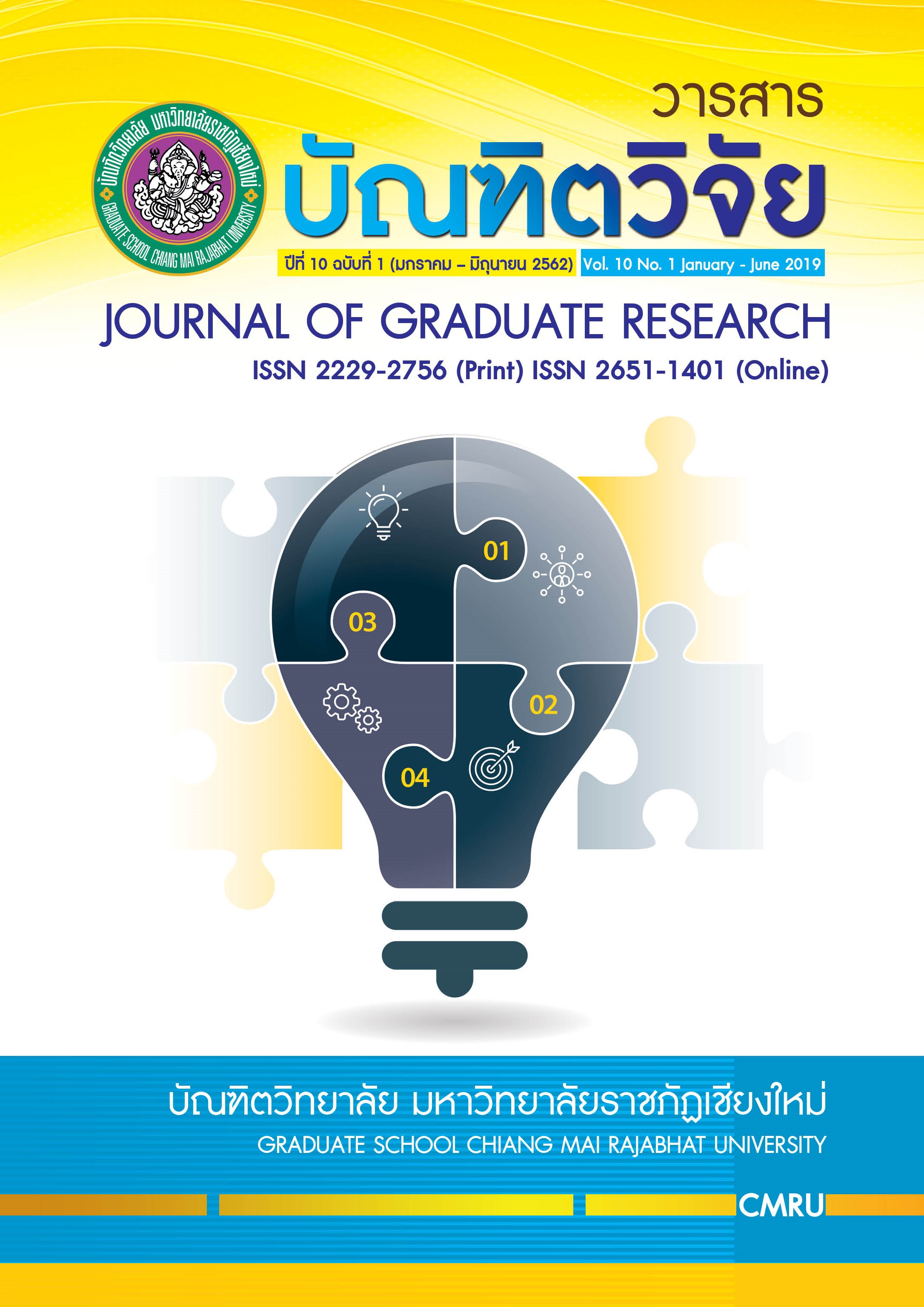Factors Affecting Organizational Health of Basic Education Schools in Chonburi Campus 1 Under the Office of Chonburi Secondary Educational Service Area 18
Main Article Content
Abstract
The purposes of this research were to study 1) the level of factors affecting organizational health in basic education schools; 2) the level of organizational health in basic education schools; 3) the relationship between factors affecting organizational health and organizational health in basic education schools; and 4) factors affecting organizational health in basic education schools. The selected sample by using random sampling consisted of 284 teachers of basic education schools in Chonburi campus 1 under the office of Chonburi secondary educational service area 18. The research instrument was a 5 point Likert scale questionnaire. The statistics used for data analysis were frequency, mean, standard deviation, Pearson Product Moment Correlation Coefficient, and stepwise multiple regression analysis. The results were as follows: 1) The level of factors affecting organizational health in basic education schools, as a whole, was at a high level ranking by mean scores from high to low: organizational structure, external environment, social system, motivation, and leadership. 2) The level of organizational health in basic education schools, as a whole, was at a high level ranking by mean scores from high to low: focusing on academic, relationship, resource support, adequate communication, and organization strength. 3) The factors affecting organizational health and organizational health in basic education schools had highest positive correlation ( = .801) with statistical significance of .01 4) The factors affecting organizational health in basic education schools were organizational structure, social system, external environment, and leadership that were able to predict at 66.40%.
It could be written in the multiple regression equation of raw score as:
= 1.251 + .227X2 + .238X4 + .130X5 + .115X1
It could be written in the multiple regression equation of standard score as:
= .310X2 + .301X4 + .177X5 + .165X1
Article Details
References
คณพงศ์ ดาเลิศ. (2555). ปัจจัยที่ส่งผลต่อสุขภาพองค์การของโรงเรียนสังกัดเทศบาลในเขตภาคตะวันออกเฉียงเหนือตอนบน. (วิทยานิพนธ์ปริญญาครุศาสตรมหาบัณฑิต, สาขาวิชาการบริหารการศึกษา มหาวิทยาลัยราชภัฏอุดรธานี).
เจริญ ควรหา. (2552). ศึกษาความคิดเห็นของครูทางด้านสุขภาพองค์การของสถานศึกษา สังกัดสำนักงานเขตพื้นที่การศึกษาระยอง เขต 2. (วิทยานิพนธ์ปริญญาครุศาสตรมหาบัณฑิต, สาขาการบริหารการศึกษา มหาวิทยาลัยราชภัฏรำไพพรรณี).
ธร สุนทรายุทธ. (2551). การบริหารจัดการเชิงปฏิรูป: ทฤษฎี วิจัย และปฏิบัติทางการศึกษา. กรุงเทพฯ: เนติกุล การพิมพ์.
วิเชียร วิทยอุดม. (2554). ทฤษฎีองค์การ: ฉบับแนวใหม่. กรุงเทพฯ: ธนวัชการพิมพ์.
ปรีดา โชติธรรมวาทิน. (2554). สุขภาพองค์การของโรงเรียนประถมศึกษาขนาดเล็กในจังหวัดนครราชสีมา. (วิทยานิพนธ์ปริญญาศึกษาศาสตรมหาบัณฑิต, แขนงวิชาการบริหารการศึกษา มหาวิทยาลัยสุโขทัย ธรรมาธิราช).
สราวุฒิ ปุริสา. (2553). ปัจจัยที่ส่งผลต่อสุขภาพองค์การของสถานศึกษาขั้นพื้นฐาน สังกัดสำนักเขตพื้นที่การศึกษายโสธร. (วิทยานิพนธ์ปริญญาการศึกษามหาบัณฑิต, สาขาวิชาการบริหารการศึกษา มหาวิทยาลัยมหาสารคาม).
สำนักงานเขตพื้นที่การศึกษามัธยมศึกษา เขต 18. (2559). การบริหารโรงเรียน สังกัดสำนักงานเขตพื้นที่การศึกษามัธยมศึกษา เขต 18. ชลบุรี: สำนักงานเขตพื้นที่การศึกษามัธยมศึกษา เขต 18.
สำนักงานเขตพื้นที่การศึกษามัธยมศึกษา เขต 18. (2560). วิเคราะห์เปรียบเทียบผลคะแนนเฉลี่ย O-NET ปีการศึกษา 2556/2557/2558/2559. กรุงเทพฯ: จามจุรีโปรดักส์.
สุขุม เฉลยทรัพย์. (2560, 25 ธันวาคม 2560). “การศึกษาไทย” ในสายตาบุคลากรทางการศึกษา. สืบค้นจาก https://dusitpol.dusit.ac.th/poll/view.phpID=1798/
สุพานี สฤษฎ์วานิช. (2552). พฤติกรรมองค์การสมัยใหม่แนวคิดและทฤษฎี. (พิมพ์ครั้งที่ 2). กรุงเทพฯ: โรงพิมพ์มหาวิทยาลัยธรรมศาสตร์.
อรัญญา สารีโพธิ์. (2553). ปัจจัยที่ส่งผลต่อสุขภาพองค์การของโรงเรียนประถมศึกษา สังกัดสำนักงานเขตพื้นที่การศึกษาหนองคาย. (วิทยานิพนธ์ปริญญาครุศาสตรมหาบัณฑิต, สาขาวิชาการบริหารการศึกษา มหาวิทยาลัยราชภัฏอุดรธานี).
Daft, R. L. (1986). Organizational Theory an Design. (2nd Ed.). New York: McGraw Hill.
Davis, G. A. (1989). Effective schools and effective teachers. Boston: Allyn and Bacon.
Flippo, E. B. (1980). Personnel Management. (5th Ed.). New York: McGraw-Hill.
Healy, M.B.S. (1994). Beyond in a Secondary School: A Change for the Best. In C. Persons Quality Improvement Education. (5th Ed.). London: David Fulton.
Hoy, W. K., & Feldman, J. A. (1987). Organizational Health: The concept and its Measure. Journal of Research and Development in Education, 20(4), 32.
Hoy, W. K., & Sabo, J. D. (1997). Quality middle schools: Open and healthy. Eaglewood Cliffs, NJ: Prentice-Hall.
Hoy, W. K., Tarter, C. J., & Kottkamp, R. B. (1991). Open school/healthy schools. London: Sage Publication.
James, L. R., & Jones A. P. (1974). Organizational Climate, A Review of Theory and Research. Psychological Bulletin, 81(4) (December 1974), 1098-1099.
Krejcie, R.V. & Morgan, D.W. (1970). Determinining sample size for research activities. Educational and Psychological Measurement, 30, 607-610.
Owens, R. G. (2007). Organization behavior in education: Adaptive leadership and school reform. (9th Ed.). Boston, MA: Pearson/ Allyn and Bacon.
Steers, R. M. (1997). Organization Effectiveness: A Behavioral View. Santa Monica, California: Good Year Publishing Company Inc.

